Powering the RC211V out of Valencia's final left-hander onto the start-finish straight for the first time is simply an unforgettable experience. Valentino Rossi's MotoGP-winning 990cc V-five has been remarkably rider-friendly on this first cautious lap. But when I get to yank the throttle open for the first time, the Honda hurtles forward with a fury I've before experienced on a racetrack.
Within a few moments and a couple of treads on the quick-shift-enabled gearbox, the RC is scorching past the blurred figures on the pit wall while I peer into the distance, already frantically searching for a braking marker for the fast-approaching left-hander at the end of what is suddenly a very short straight. Even the mighty NSR500 I rode earlier in the day at this end-of-season HRC test seems almost sluggish by comparison.
Perhaps the most remarkable thing about the RC211V is that it's also so controllable. Despite ferocious acceleration from its blend of 220 horsepower and just 319 pounds of weight, the Honda's bars point straight ahead even when the front wheel flicks into the air through the lower gears. Having heard riders including Rossi and Alex Barros talk about the speed and rideability of the RC-V, I'd expected it to be more rider-friendly than the NSR, but I hadn't expected the differences to be so pronounced. Whereas the two-stroke V4 feels and sounds like the finely honed but thoroughly anti-social beast that it is, the four-stroke V5 is polite, well-mannered - and so fast it drains your blood into your boots.
This speed has been obvious throughout a debut season that must go down as the most impressive by any bike in the history of racing's premier class. The RC211V won 14 of the year's 16 grands prix, including the first nine, its only real rival being the Yamaha YZR-M1 on which Max Biaggi won two races. (For comparison, Honda's NS and NSR500s each won just three of their first season's 12 races in the '80s, and the 500cc RC181 ridden by Mike Hailwood and Jim Redman won five of nine in 1966.) Rossi finished first or second in every race apart from the Czech GP in which he had tire problems. Only when Barros was given an RC-V for the last four rounds - two of which he won - could anyone run consistently with the Italian genius.
Honda's dominance was a fitting reward for the boldness the firm showed in choosing to develop a V-five in 2000, after the rule change allowing 990cc four-strokes had been confirmed. An innovative approach is visible all over the bike that Honda named the RC211V: RC is the firm's traditional racing designation; 211 means the first works bike of the 21st century; and the V is for both the engine type and the number of cylinders in Roman numerals). While Yamaha and Suzuki used familiar straight-four or V4 engines in frames derived from those of their two-stroke GP predecessors, Honda began with a clean sheet of paper. But crucially, it didn't make the same mistake the designers of the NR500 of the late Seventies did when they mixed in too much new technology at once.
One of the most striking aspects of the RC-V is its small and apparently un-aerodynamic fairing, designed partly because Honda discovered that a big fairing's advantage in straight-line speed came at the expense of cornering stability. The V5's sheer horsepower, combined with the relatively tight layout of most modern GP tracks, also helped inspire cut-down bodywork that not only allows the gearbox internals to be changed without removing any carbon-fiber, but also gives the Honda a distinctive look.
The Honda looked scarily aggressive as it stood in a Valencia pit garage wearing tire warmers, while the Repsol mechanics topped up its gas tank, and I stood nervously alongside, waiting for my most eagerly awaited ride of this or any other year. The bike seemed minute, although at 1440mm its wheelbase is 40mm longer than the NSR's. When finally I got the nod to climb aboard I was relieved to find that the RC-V, which was set up just as the relatively tall Rossi had left it after finishing second after an epic scrap with Alex Barros here the previous day, was quite roomy.
From the fairly low seat the view forward was of a low screen and clip-ons, a rough-cast top yoke, a black-faced tacho reading to 17,000rpm alongside a digital display showing lap time and engine temperature. On the left bar was a three-way switch giving alternative engine-management maps, including one that Rossi uses to reduce power on the start line. With no need of that I accelerated out on the empty track, conscious of the crisp and clear five-cylinder bark from the twin silencers as the engine revved towards its 14,200-rpm limit through the gears. The Honda felt deliciously neutral and confidence inspiring as I cranked through the twisty Valencia infield.
The bike's handling was immediately impressive, but if there was one RC-V feature that stood out above all others it was the sheer force of that amazing engine. Whether it was grunting out of slow turns with an effortless yet utterly linear surge or howling down that start-finish straight at an unprecedented rate towards a top speed that would reach well over 200 mph if given enough space (Rossi hit 190 even on this short straight), the Honda was never anything less than breathtaking.
Its fuel-injection response was so sweet that I never once even thought about it. The six-speed gearbox and electronic quickshift similarly worked to perfection, my only slight problem being that because I'm tall the lever was set slightly too high, which had me lifting my foot slightly off the peg to hook a lower gear with the reverse-pattern shift. The Honda's midrange delivery was so strong that the RC-V pulled stunningly hard out of the first left-hander whether I was in second or third gear.
One of the HRC engineers' key chassis design aims was to keep the center of gravity low for improved stability. So it was no surprise that the RC-V, which carries much of its fuel low down below the seat, was so stable, both under hard acceleration and when using the stunningly powerful front brake blend of carbon discs and four-pot Nissin calipers. The bike also had a phenomenally rock-solid feel through the turns, feeling so neutral and well balanced that it almost seemed to be laughing at my efforts to make it work hard.
Perhaps inevitably, the RC could not be flicked around with quite the ludicrous ease of the 33-pound lighter NSR. Just as with the V5's speed edge, I was slightly surprised that what is in some ways a fairly small advantage should make such a noticeable difference. At race pace the RC-V's purpose-built twin-spar aluminum frame would really come into its own, because it is designed to flex slightly when the bike is cranked over in corners. This helps the front suspension reduce chatter, and also gives the rider more feel when the rear tire is sliding.
My five laps were up long before I'd found the confidence to test that theory, which is probably just as well given this bike's value and rarity. Honda's efforts to make the V5 rider-friendly have paid off, and I would happily have kept going until the fuel ran out. (A roadgoing version of this bike would be sensational. Please, Honda!) Instead, I warbled back into the pits with a huge and slightly relieved grin on my face.
As always, with any brief works racer test like this, I'd barely scratched the surface of the RC211V's vast potential. But more than with any previous GP machines I've ridden, I had the feeling that I could have pushed much harder without getting bitten. In this job I'm often asked which is the best bike I've ever ridden, and I normally mutter something about how bikes are all so different that it depends what you want one for.
But not any more. Since riding the RC211V, that question can have only one answer.
RC211V Tech'
Honda's exotic V-five has its origins in a promising V6 prototype called the FXX, which RC211V project leader Tomoo Shiozaki helped develop back in 1988. This was designed specifically with the goals of compactness and mass centralization. It outperformed the RC30, Honda's all-conquering V4 sportster, and handled superbly. But with the market demanding race-replicas and Honda competing successfully with RC30s in the new World Superbike series as well as Formula One and endurance, the V6 never reached production.
More than a decade later, Shiozaki and his team brought similar properties to the RC211V. The V5 engine layout was inspired by the MotoGP rule that limits both four- and five-cylinder bikes to the same 145kg minimum weight. Honda quickly decided against a single or twin due to their lower performance; and against a six because that would have meant a weight 10kg above the 145kg figure for fours or fives, making tire problems likely. Having narrowed the choice, Honda went for a V5 instead of V4 or a lighter triple, mostly because the engineering team fancied the challenge. Five cylinders would give more power than four; indeed, the RC211V's 990cc unit not only produces close to 220 bhp at 14,000 rpm, but does so with impressive and controllable torque from low revs, as well as being relatively easy on rear tires.
The V5, whose layout places three cylinders facing forwards and two rearwards at 75.5 degrees, is considerably smaller than alternative engines with fewer cylinders. According to Honda the RC-V's semi-dry-sump design, which puts oil in the gearbox cavity, also aids compactness as well as reducing blow-by. This cylinder angle gives perfect primary balance, so no power-sapping counterbalancer is needed.
Honda still refuses to give cylinder dimensions of the dohc, 20-valve unit, but has confirmed that the five cylinders are the same size (rather than the rear pair being slightly larger, as was rumored). There is also no word on firing order, or to what - if any - degree traction-control is used. Complex and expensive features such as pneumatic valves are conspicuous by their absence, partly because they're not necessary (not yet, at least). One piece of technology the engine does use is its slipper clutch, designed to improve stability when braking, which handicapped Rossi in some late-season races before the problem was cured.
Honda's long-term aim with the RC-V has always been to produce engines for satellite teams, as will happen in the 2003 season, when at least eight riders will use the V5. The motors will cost more than NSR units, but last longer. The Repsol team's 20-valve RC motors were run for almost 2000 miles before being shipped back to the factory for major rebuilds, although cylinder heads were checked between races. The engine proved very predictable in its performance, requiring little of the fine-tuning that used to keep Rossi's crew chief Jeremy Burgess busy with the NSR500.
The RC-V's sophisticated injection system also helps give the pit crew an easier time by making the bike easy to set up when the team arrives at a new circuit. Each cylinder has one injector positioned upstream of the throttle valve, for wide-open delivery, and one downstream for low- and midrange performance. Electronic tricks to improve throttle control include using the ECU to vary the pressure in the injection system, resulting in precise fuel supply. The complex titanium exhaust system ends in twin silencers, one in the seat unit and the other on the bike's right side.
Creating the RC211V's chassis from scratch - rather than basing it on an existing frame as Yamaha and Suzuki did - allowed a slightly longer wheelbase. This gave added stability under braking and acceleration, along with a lower center of gravity for the same reason. Much of the fuel is located beneath the seat in the space vacated by the redesigned Unit Pro-Link swingarm assembly, which anchors both ends of the shock to the arm rather than the frame. Both the frame and swingarm are also purpose designed to have very high torsional (anti-twisting) rigidity, but to be slightly less laterally rigid than their NSR500 equivalents, as Honda believes that a small amount of flex improves the rider's feel and helps the suspension at extreme lean angles. Trick indeed.










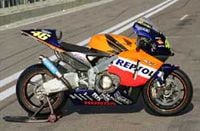
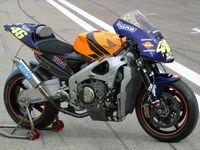
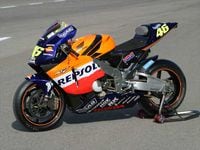


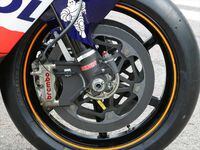


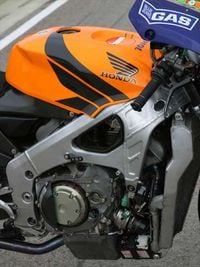
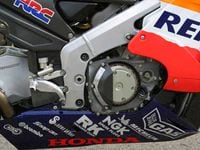

/cloudfront-us-east-1.images.arcpublishing.com/octane/TNOU5DNE2BC57MFPMGN2EIDXAM.jpg)
/cloudfront-us-east-1.images.arcpublishing.com/octane/GTCXACQGJ5HAPDTGWUQKDEH44E.jpg)
/cloudfront-us-east-1.images.arcpublishing.com/octane/S35YGSEMEZB4BLTDJTSZPF4GLA.jpg)
/cloudfront-us-east-1.images.arcpublishing.com/octane/5UOT6HPX2JFMRJAX6EH45AR4MQ.jpg)
/cloudfront-us-east-1.images.arcpublishing.com/octane/OKWOJWAKP5EP3OACCRRWPCIX2Q.jpg)
/cloudfront-us-east-1.images.arcpublishing.com/octane/2WF3SCE3NFBQXLDNJM7KMXA45E.jpg)
/cloudfront-us-east-1.images.arcpublishing.com/octane/G4MG6OUCJNBSHIS2MVVOTPX65E.jpg)
/cloudfront-us-east-1.images.arcpublishing.com/octane/IIGGWFOTOJGB7DB6DGBXCCMTDY.jpg)
/cloudfront-us-east-1.images.arcpublishing.com/octane/QSTCM6AVEZA5JJBUXNIQ3DSOF4.jpg)
/cloudfront-us-east-1.images.arcpublishing.com/octane/U4I7G625B5DMLF2DVIJDFZVV6M.jpg)
/cloudfront-us-east-1.images.arcpublishing.com/octane/B6XD6LS6IVCQPIU6HXDJSM3FHY.jpg)
/cloudfront-us-east-1.images.arcpublishing.com/octane/ICL63FEDDRDTTMINYICCEYGMDA.jpg)
/cloudfront-us-east-1.images.arcpublishing.com/octane/FCGZHQXRBZFLBAPC5SDIQLVF4I.jpg)
/cloudfront-us-east-1.images.arcpublishing.com/octane/WNOB6LDOIFFHJKPSVIWDYUGOPM.jpg)

/cloudfront-us-east-1.images.arcpublishing.com/octane/X33NU3E525ECRHXLNUJN2FTRKI.jpg)
/cloudfront-us-east-1.images.arcpublishing.com/octane/6KKT5NNL2JAVBOXMZYS5ZO76YA.jpg)
/cloudfront-us-east-1.images.arcpublishing.com/octane/J5RKG5O455GMPGQRF2OG6LRT7A.jpg)
/cloudfront-us-east-1.images.arcpublishing.com/octane/GX2CIZKQVRH2TATDM26KFG2DAE.jpg)
/cloudfront-us-east-1.images.arcpublishing.com/octane/ZWIDYSAKQZHD5BHREMQILXJCGM.jpg)
/cloudfront-us-east-1.images.arcpublishing.com/octane/CYUHJZCTSJCH3MRAQEIKXK7SCQ.jpg)
/cloudfront-us-east-1.images.arcpublishing.com/octane/LKOFINY56FCXJCANJ5M7ZDQUBY.jpg)
/cloudfront-us-east-1.images.arcpublishing.com/octane/4NBPDACMWJH63JQYJVK3QRBDZI.jpg)
/cloudfront-us-east-1.images.arcpublishing.com/octane/KKHQHRR3FJGX7H2IPU6RALMWG4.jpg)